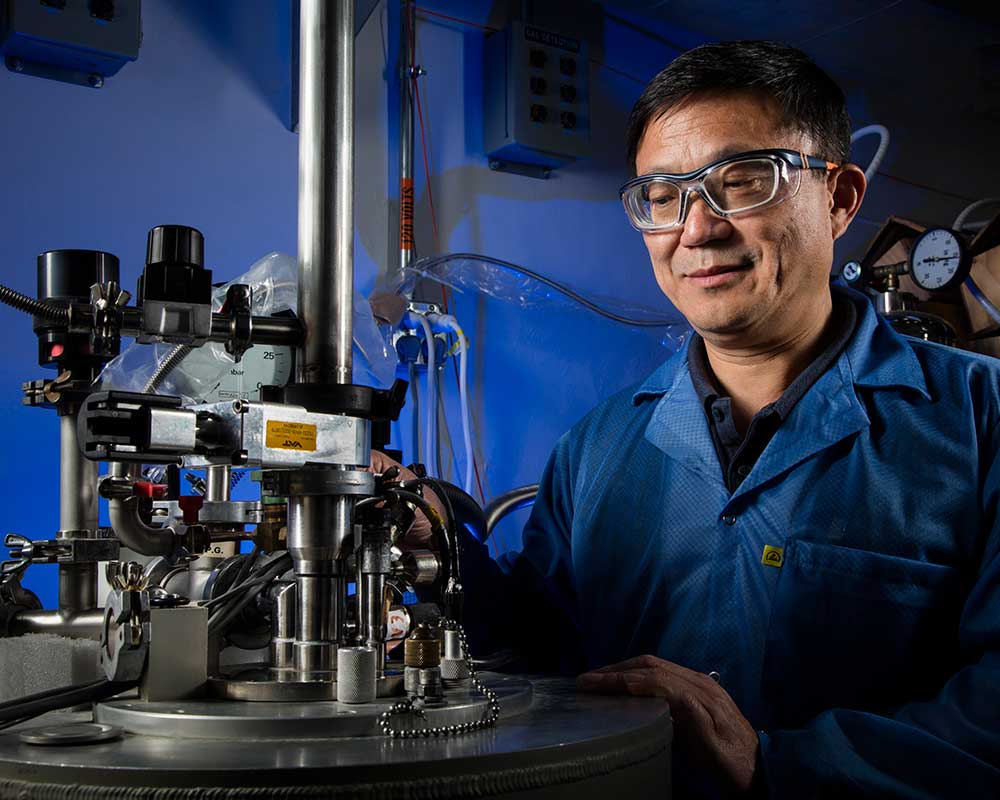American Physical Society honors researcher with fellow appointment

Wei Pan may study electrons, but he is incredibly positive about his work and thankful for his election this year as a Fellow of the American Physical Society.
“I am grateful to the Division of Condensed Matter Physics of APS for the selection,” Wei said, specifically thanking material scientist Jeff Tsao, retired Sandian John Aidun, and his manager Ashfia Huq for supporting his nomination.
The American Physical Society admitted him to their prestigious roster of fellows for “the discovery of several unconventional fractional quantum Hall states, and for innovative experiments exploring the excitonic insulator phase in InAs/GaSb, Majorana particles, topological superconductivity and Leggett modes in Dirac semimetals.”
“The fractional quantum Hall effect (FQHE) is a physical phenomenon due to a collective motion of electrons in a two-dimensional flatland, like a waltz dance of a group of people,” Wei said. “FQHE has important implications for fault-tolerant quantum computing. There are many types of FQHE states, kind of like many types of dancing styles. I was fortunate to discover a few of them.”
Wei studied quantum phenomena that were theorized but not observed, through experiments that were not possible until the combination of the right materials and resources were brought together.
“This was not an easy task,” Wei said. “In general, these phenomena are topological. It studies things that are invariant under a continuous deformation. For example, one can deform a coffee mug continuously into a donut because they have the same topology — both have a hole. In physics, topology normally means protection. If a physics phenomenon is topological, it means this phenomenon is robust and immune from their environmental perturbations. Imagine that we can utilize this topological protection to build a quantum computer. This kind of quantum computer would be much more robust than the one built by Google. As a result, a topologically protected quantum computer can be used for general purpose computing such as designing new medicines.”
The journey from theory to experimentation is exactly what excites Wei, who said his path began sometime around elementary school.
“I remember reading the stories about Albert Einstein and found them exciting and fascinating,” he recalled. “That’s probably when my interest in science began. I still have an Einstein poster in my home! On the poster, it says ‘Gravitation cannot be held responsible for people falling in love.’”
From that early foundation, Wei charted a path to one of the most renowned learning institutions in the world.

“When I was an undergraduate student, I was good at learning existing knowledge but did not have a chance to discover new things,” he said. “It is the graduate study experience I got while earning my Ph.D. from Princeton University that really enabled me to unlock the joy of discovery.”
Wei joined Sandia in 2003 after earning his doctorate. He worked in Albuquerque until 2017 when he transferred to the Livermore site, where he works today. Wei said he has felt supported throughout his odyssey of innovation and discovery at Sandia, expressing gratitude to those who took their time and energy to help him.
“There are a lot of people I am indebted to for helping me grow and advance,” he said. “My Ph.D. thesis advisors professor Daniel Tsui and proffessor Dr. Horst Stormer were crucial resources for me. Jerry Simmons hired me into Sandia and gave me the freedom to explore things. Of course, to my colleagues who help my research, and to Sandia LDRD program and DOE Basic Energy Sciences program for funding the research.”
Wei’s advice for a path in research: “Follow your own interest. This can propel you longer and deeper in your research journey.”
“I want to thank my family for their strong support of me pursuing scientific research,” he said. “Without their selfless support, I wouldn’t be able to achieve what I have done. Second, I am fortunate to work with many people at Sandia. They have helped me tremendously, scientifically and personally.”